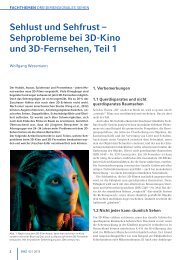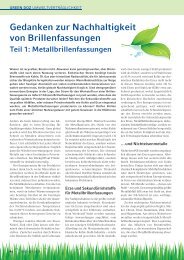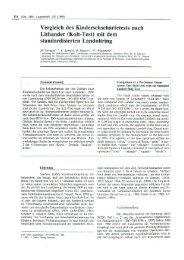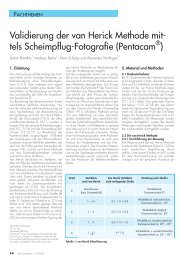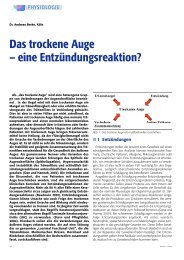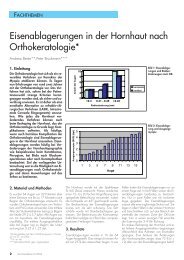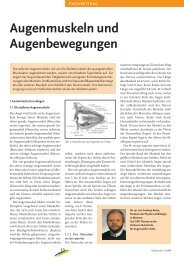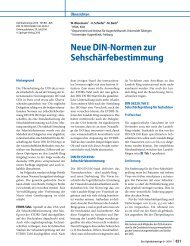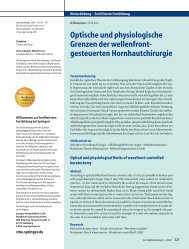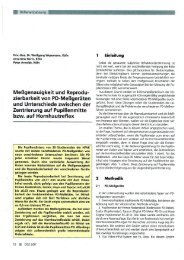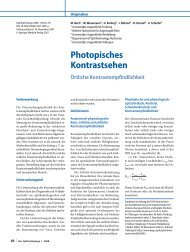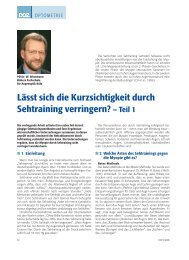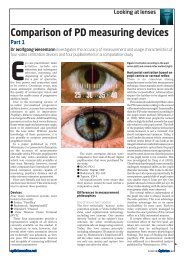Clinical evaluation of refraction using a handheld wavefront ...
Clinical evaluation of refraction using a handheld wavefront ...
Clinical evaluation of refraction using a handheld wavefront ...
You also want an ePaper? Increase the reach of your titles
YUMPU automatically turns print PDFs into web optimized ePapers that Google loves.
HANDHELD WAVEFRONT AUTOREFRACTOR IN YOUNG AND ADULT PATIENTS<br />
Figure 5. (Schimitzek) Individual SEs measured by the SureSight<br />
versus cycloplegic retinoscopy (Group 2). Upper panel: Both measurements<br />
under cycloplegia. Lower panel: SureSight without cycloplegia.<br />
The cycloplegic results agree well with retinoscopy. All data<br />
points lie close to the diagonal line that indicates perfect agreement.<br />
Without cycloplegia, many data points lie below the diagonal DSE <br />
0 D line, indicating a minus-overcorrection. The accommodating patients<br />
are mainly children (triangles) and young adults (squares). The<br />
additional dotted line at 2 D shows the autorefractor reading that<br />
would be expected when patients accommodate at a distance <strong>of</strong><br />
0.5 m.<br />
ment. This illustrates the fact that the SEs found with<br />
the <strong>wavefront</strong> autorefractor under cycloplegia were similar<br />
to the values obtained with cycloplegic retinoscopy.<br />
Without cycloplegia (lower panel), many data<br />
points obtained by the SureSight fell below the diagonal<br />
line. These data points indicate a minus-overcorrection<br />
by the <strong>wavefront</strong> autorefractor. It is obvious from Figure<br />
5 that minus-overcorrected results were more frequent<br />
in emmetropic and hyperopic patients. More than 50%<br />
<strong>of</strong> all children with hyperopia 1.0 D were minus-overcorrected<br />
by more than 2.0 D. Ten <strong>of</strong> 57 children eyes<br />
showed a minus-overcorrection <strong>of</strong> 2.0Dto4.0 D.<br />
An even larger minus-overcorrection <strong>of</strong> 4.13 D to<br />
6.13 D was seen in 15 eyes. The median <strong>of</strong> the difference<br />
between the SEs under and without cycloplegia in<br />
the subgroup <strong>of</strong> children was 2.22 D.<br />
The data <strong>of</strong> the emmetropic and hyperopic young<br />
adults (squares) also lie consistently below the diagonal<br />
line. The old adults, however, show no significant differences<br />
under and without cycloplegia.<br />
Discussion<br />
Analysis <strong>of</strong> Autorefractor Problems Caused<br />
by Accommodation<br />
In the present study, a large number <strong>of</strong> children and<br />
young adults accommodated during the noncycloplegic<br />
auto<strong>refraction</strong>. What was the reason for this undesired<br />
accommodation?<br />
Conventional autorefractors suffer from “instrument<br />
myopia.” Conventional autorefractors measure at close<br />
range and use special fogging techniques to relax accommodation.<br />
These fogging techniques work well on<br />
adults and reduce the so-called instrument myopia substantially.<br />
In children, however, these fogging techniques<br />
are less effective. 11 A physiological explanation<br />
for the undesired instrument myopia is that the children<br />
“feel” the fixation target very close to their eyes.<br />
Distant autorefractors suffer from “fixation myopia.”<br />
Several companies have tried to develop computerized<br />
eye <strong>refraction</strong> devices that operate from a longer distance.<br />
The first fully operational instrument <strong>of</strong> this kind<br />
was the Topcon pediatric refractor PR1100. 17 Modern<br />
alternatives are the PowerRefractor 14 and the SureSight.<br />
In addition, a new open-field autorefractor has been<br />
recently introduced by Shin-Nippon. 18,19 This autorefractor<br />
is a successor to the well-known Canon R1 and<br />
allows a binocular field <strong>of</strong> view through a large beam<br />
splitter. However, all these refractors have a common<br />
disadvantage: They do not have a fogging system.<br />
Distant autorefractors use real fixation targets that<br />
are mounted close to the front end <strong>of</strong> the instrument or<br />
to the wall <strong>of</strong> the examination room. When a hyperopic<br />
patient is asked to look at the fixation target, he or she<br />
may start to accommodate. As a result, the autorefractor<br />
will measure the eye not in its relaxed position but in a<br />
state <strong>of</strong> pseudo-myopia.<br />
When a patient accommodates exactly at the front<br />
end <strong>of</strong> the SureSight (0.35 m), the instrument should<br />
J CATARACT REFRACT SURG—VOL 28, SEPTEMBER 2002 1661



